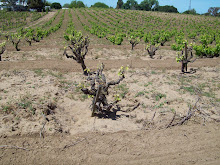
Man, ya gotta hand it to Matt Cline. Dude tells it like it is, and the way it is actually is the way he tells it. And I don’t mean that in the obituary sense. C’mon, you know what I’m talking about: When the best descriptors in an obit notice include “he marched to his own drummer’ or “not afraid to speak his mind,” not to mention “some said curmudgeon” or “irascible,” you know they were talking about a mean SOB in life.
Matt’s not dead, and he’s a cool dude.
Sitting down to chat with this venerable winemaker the other day, I opened with my stock line about Kathy and I, living in Oakley, CA for just now one year, being blown away by the sight of old-vine vineyards directly beside new housing developments, in one of which we now live. I got schooled immediately.
“More like housing developments right beside old vineyards,” he noted. Touché, Monsieur Cline.
As noted before, the Cline family, and the Jacuzzi side of la familgia, have been a major presence in CoCo County, and our Oakley burg in particular, for generations; their roots to the region as deep as those of the century-old vines themselves. Matt calls the gnarly, ancient plants “stupid vines”: They’re old, content to rest in infertile sand, unproductive, and only too happy to withstand the river delta winds that can shut down their physical ripening “just like fog.” But, as he opines, major brands like Rosenblum and Bonny Doon “would have been nowhere without Oakley fruit.”
For over 16 years, beginning in 1984, Matt worked alongside his bro Fred at the family biz, Cline Cellars, watching production ratchet up exponentially from 300 cases to 250,000 cases annually.
Matt eventually struck out on his own to found, with his wife, Erin, and partners, the Trinitas label, making his first vintage in 2001. He made Trinitas’ early wines at Wente, south of Oakley in Livermore, before eventually making the move to their own facility in Napa. A few years later, with the ‘05s in the barrel and the ‘06s in the tank, Matt contemplated buying out his partners. To his pleasant surprise, the partners made a generous offer to buy HIM out.
He sold on Christmas 2006. The day after Christmas, he and Erin started Three Wine Company. One of their first releases was “Rotten Riesling,” a late-harvest-style varietal wine with grapes affected by the “noble rot” botrytis fungus, and which proceeded to win the San Francisco Chronicle Sweepstakes Award.
The interesting thing about the sale of Trinitas is that Matt’s Oakley-area grape contracts were not part of the deal. And that’s when Matt schooled me again: A surprising number of these orphan vineyards in unusual locations through the region are actually owned by housing developers and corporate concerns who persuaded old-time growers to sell their acreage. And, when the economy went south and stalled development, many of the new owners decided that it made sense to just leave the vines and lease them out to other growers and winemakers. It’ll be interesting to see just how many of these small, area vineyards, that Kathy and I pass daily, we’ll still see if the economy improves.
BTW: you know that vineyard right beside the Oakley Post Office? Matt leases it! It’s planted to Alicante Bouschet and Mataro (Matt never call it “Mourvèdre” If “Mataro” was good enough for the immigrants who planted it, it’s good enough for Matt), and he co-ferments it with Zinfandel for some of his blends. He also leases some plots of Petite Sirah, and sources old-vine Carignane from the Lucchesi Vineyard located on a sand dune in an area purchased by the state of California as a waterfront preserve.
Matt Cline doesn’t have much good to say about over-ripe, super-extracted Zinfandels flooding the marketplace. “It needs some Carignane and Petite Sirah for complexity," he states. Emphatic to the end, he repeats, in case anyone missed it, “Zin ain’t Zin without some Carignane.”
Which actually makes a great segue to a couple of bottles that Kath was able to obtain. The Three 2007 Lucchesi Carignane is sourced from that state-owned sand dune vineyard mentioned above. It’s an absolutely gorgeous bottle of wine: a look of translucent coruscating garnet, and a nose of earth, citrus peel and smoky chocolate-covered cherry. It’s bright in the mouth, with hints of white pepper and a fine acidity contributing to the long finish.
Three’s 2008 Contra Costa County Petite Sirah is a big bruiser. Swirling the wine shows off a heavyweight with a blue edge to indicate its relative youth. It shows off a nose of dried blueberry, with boysenberry jam and touches of tobacco and cedar. Earthy berry flavors on a frame of nicely integrated tannins go on and on.




